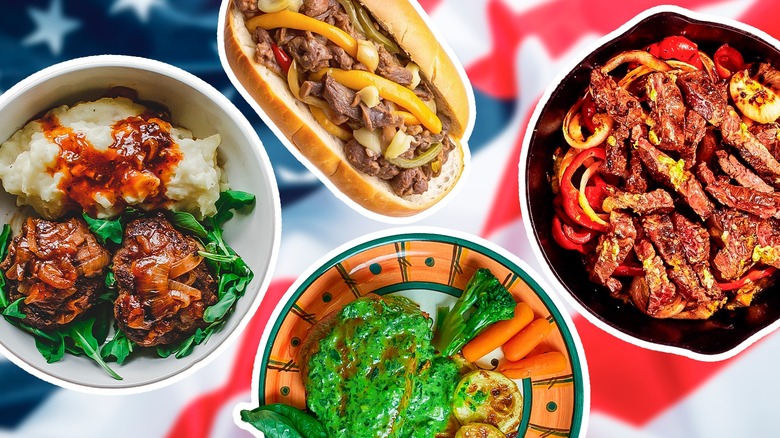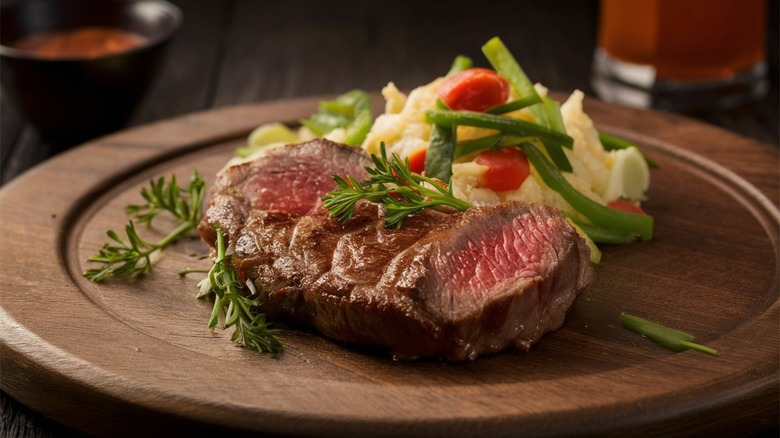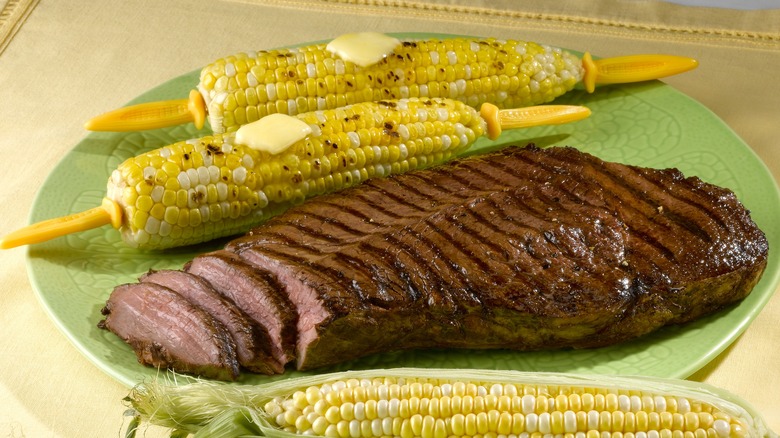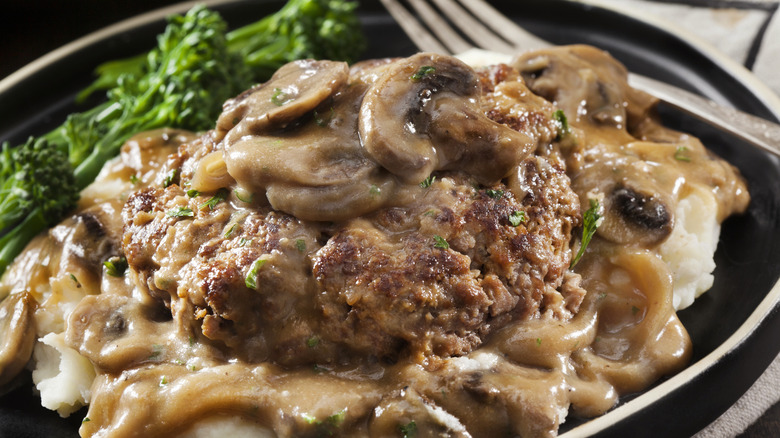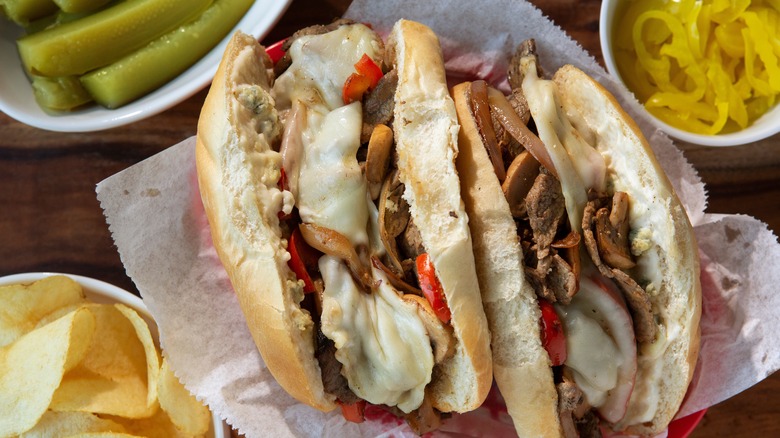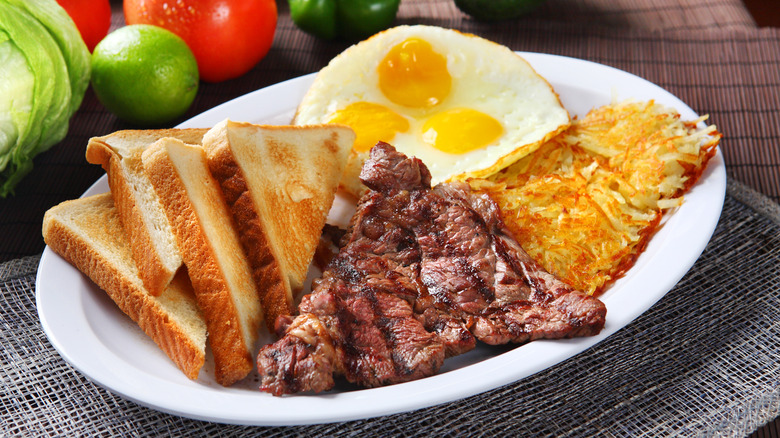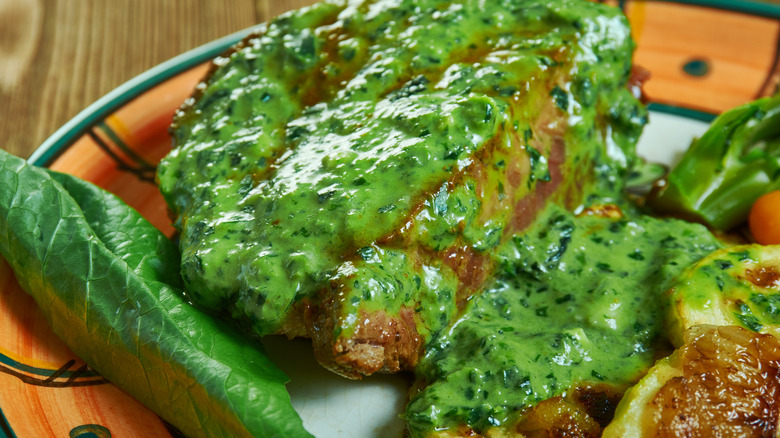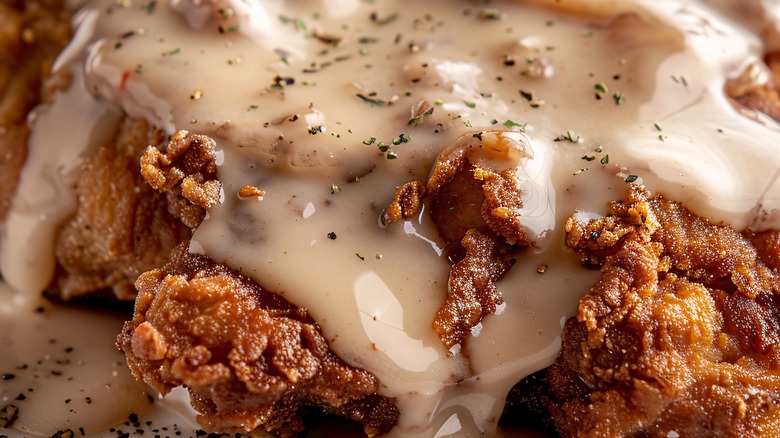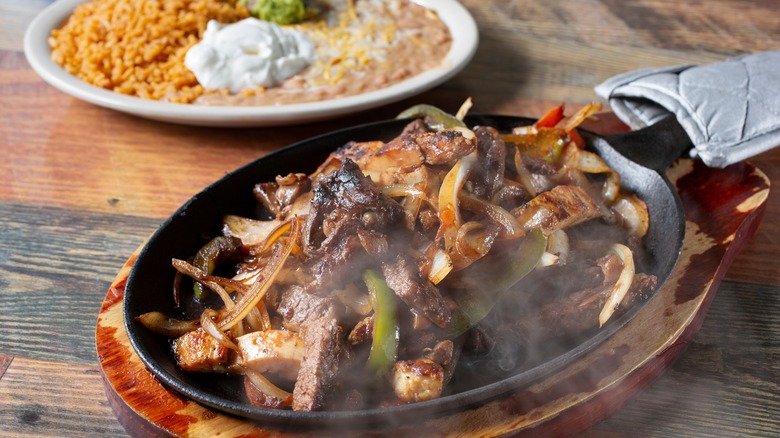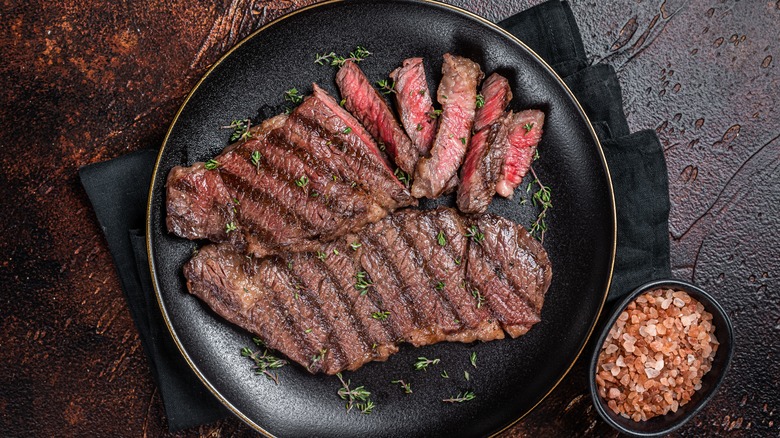10 Iconic Steak Dishes That Were Invented In America
America can take credit as being the place where many famous dishes were made, including everything from the peanut butter and jelly sandwich to the perfect chocolate chip cookie. But that begs the question: Where's the beef?
Data gathered by the United States Department of Agriculture claims that the average American consumes nearly 60 pounds of beef per year. And while that certainly comes in the form of hamburgers, all-beef hot dogs, and more, it's safe to say that steak probably makes up a good chunk of it. The role of the beef industry, and the culture surrounding the consumption of steak, has certainly propelled folks to get creative with how to cut, serve, and enjoy it. As a result, the United States was the nexus of creation for several different iconic steak dishes, many of which are still served in upscale steakhouses and humble diners across the country even today. We did some digging to find out the true origins of each of these meaty dishes, as well as what exactly each one of them is.
Delmonico steak
Delmonico's is widely considered to be the first fine dining spot in the country, so it makes sense that it would have at least one iconic and historically relevant dish on its menu. The restaurant, which has been located in New York City's Financial District since 1837, is responsible for bringing many different dishes into the American culinary lexicon; its chef de cuisine, Charles Ranhofer, created popular dishes in the mid-19th century, including eggs Benedict, baked Alaska, and chicken a la Keene.
But this steak dish is undoubtedly the north star of Delmonico's and its creations. Chef Alessandro Fellippini was previously credited with creating the Delmonico steak. Both his and Ranhofer's recipe books call for sirloin steaks, but the exact cut of high-quality beef used is actually hotly contested these days — and it may not have even been consistent back then due to availability. Indeed, several cuts have since been associated with this steak: Is it top sirloin, short loin, or ribeye? Boneless or bone-in?
Regardless, the Delmonico steak remains a signature selection on the menu today in the form of an 18-ounce ribeye, which comes with the option to add sauces and a la carte sides. This steak, which Delmonico's claims only it can make perfectly, is about two inches thick and has a ton of marbling, which gives it a soft, succulent mouthfeel. This big 'ol steak is decadent and a must-try if you have the chance to visit the spot where it was created.
London broil
London broil is like the inverted version of the Delmonico steak. While the Delmonico is brimming with moisture, marbling, and fat, the London broil is the steak that got pushed through the same machine Violet Beauregarde did in Willy Wonka's chocolate factory. It's thin and lacking that same juicy mouthfeel that other types of steak offer.
Despite the fact that its name conveys images of Big Ben and Buckingham Palace, the London broil was actually created in Philly. Rather, the name was just a sneaky addition to make folks think that the cut was more sophisticated and high-end than it actually was. When it was created, the London broil was sourced from the cheapest cuts of the cow — often from the flank. But it's not just the cut that makes this steak dish unique; historically, it was always cooked under the broiler (hence its name) and covered in a peppercorn crust. Because of this cut's shape and size, it's often sliced paper-thin.
That being said, it's not a steak cut for everyone — especially for folks who really like biting into a juicy, succulent cut of meat. But when it's marinated well and cut against the grain, it can be your new favorite steak dish.
Salisbury steak
If you associate a Salisbury steak with a TV dinner, you're not entirely wrong. Although its name gives off the impression that it is indeed a steak, it's more of a lovechild between a hamburger and a meatloaf. But unlike other steak dishes on the list, the pseudo-steak itself isn't really the star of the dish; it's also the layers of succulent gravy and mushrooms poured over it. A Salisbury steak served over a heaping pile of mashed potatoes may not be the most appealing dish to the eye (not to mention, it's a dish only a grandmother could love), but it sure is flavorful.
We wouldn't have Salisbury steak without American physician Dr. James Henry Salisbury, who promoted beef as an essential part of the post-Civil War diet. Salisbury noticed that soldiers were facing malnutrition and studied how protein, specifically beef, could help improve body condition and give them the vitality they needed. Moreover, he determined that integrating chopped beef into the diet, in the form of these hamburger-like patties, was a great way to get those nutrients into hungry bodies. The gravy was just a bonus.
Philly cheesesteak
The Philly cheesesteak is like the practical, blue-collar approach to steak. While some hoity-toity people are eating elaborate cuts of steaks paired with decadent sauces in high-end steakhouses, the rest of us are ordering Philly cheesesteaks from the cart on the corner. Not only are these sandwiches brimming with meaty flavor, but they're portable and easy to eat on-the-go. Traditionally, the sandwich is made with thinly sliced flank steak (or sirloin) topped with melted provolone cheese, bell peppers, and onions on a sub roll.
As you can guess by the name, you have the City of Brotherly Love to thank for this iconic American sandwich. Pat and Harry Oliveri are given credit for first selling this sandwich from a hot dog cart in South Philly back in the 1930s — though cheese wasn't added until several years later. Now, you can get this gooey, savory, and meaty sando in almost every city in the U.S.
Steak and eggs
As a concept, steak and eggs seems a bit silly. Isn't there enough protein and savory flavor in eggs, hash browns, and a side of buttered toast to satisfy you throughout the day? Apparently not.
Technically, the idea for combining a huge hunk of steak with breakfast fare was started by the Australians. But it became more and more associated with American culture over the years that it was kind of adopted it as a food of our own (not to mention, the Australians had a dwindling egg and beef supply that kept the dish off of menus). The Marine Corps made this meal a pre-landing breakfast essential, which arguably spawned its popularity during the post-war era. It's also become associated with space and astronauts; American astronauts have been chowing down on this protein-dense meal since the 1960s.
The best cut of steak to serve with eggs for breakfast is top sirloin, though you could also use filet mignon, ribeye, or strip steaks, too. These cuts cook relatively quickly in a pan and don't require the same lengthy marinating period or a long braise. Avoid tough cuts of meat for steak and eggs because they'll take far too long to get right. In other words, save your brisket for a different occasion.
Steak de burgo
Des Moines, Iowa is home to steak de burgo, but this dish can now be found across the Midwest. This beef tenderloin filet is coated in a flavorful sauce made with garlic, basil, and oregano, and may get the upper hand from a handful of mushrooms, though this is not an essential ingredient, by any means.
The spot where this dish was invented back in the 1950s is contested. Some folks point to Vic's Tally Ho, while others point to Johnny & Kay's. Regardless, Iowans can be proud of this dish, which is brimming with buttery flavor, along with the allium-forward notes from the sauce. The herbs offer a bright green color and a wholesome flavor that itches every one of your taste buds. You really couldn't think of a simpler, tastier pairing for a succulent cut of pan-seared steak. Although it tastes like a very sophisticated dish, there are some humble origins and familiar flavors to it. Pair it with other common steakhouse sides, like garlic butter mashed potatoes, steak fries, or grilled veggies.
Chicken fried steak
We can't talk about diner food without mentioning the infamous-ish chicken fried steak. Although some people may think of it as a dinner item, it's more common to see chicken fried steak served as a breakfast food, served alongside popular items like hash and eggs. Chicken fried steak is similar to classic schnitzel because both dishes encase a thin piece of meat around the crispy, salty, and flavorful batter. This process helps lock in the moisture and adds a unique textural component to the protein.
While there are some varied origins for chicken fried steak, many folks trace it back to the Lone Star State: Texas. German immigrants flocked to Texas during the 19th century, which created a culinary fusion between foods like fried schnitzel and Texas beef. The exact batter recipe varies depending on the region it's being made in. For example, Central Texas chicken fried steak is made with eggs and breadcrumbs in the batter (which is similar to the German schnitzel), while West Texas chicken fried steak is strictly pan-fried.
Generally speaking, the go-to cut for chicken fried steak is something cheap. You'll find round steak being used, as well as top sirloin or eye of round. Other folks swear by cube steak (top or bottom round) — which is sold pre-tenderized.
Steak fajitas
Whenever the folks at Chili's walk over to us with that sizzling plate of fajitas, sputtering and smoking alongside peppers and onions, we can't help but smile. There's a star-of-the-show feeling associated with this show-stopping dish (seriously, the whole restaurant stops what they're doing and looks at you), but it's not as good as biting into the succulent pieces of steak on the platter.
Steak fajitas are often made with cheaper, thinner cuts of steak. Some of the best cuts of beef for fajitas include skirt steak, lean flank steak, top round, and flat iron. The word "fajita" literally means "sash," and refers to the diaphragm region where the skirt steak comes from. The cuts cook relatively quickly when they hit the hot pan, which helps seal in the moisture and the flavors. We can give Texas ranchers and Mexican vaqueros credit for first creating fajitas. The cheap cuts were easy to cook over an open flame, rather than in an indoor kitchen. Eventually, the fajita evolved to be a popular Texas dish — before it spread to nearly every Tex-Mex restaurant on the North American continent.
Steak tips
Steak tips are one of the many New England foods that everyone needs to try at least once. You'll find them at barbecues, bars, and more — which makes them almost as ubiquitous as clam chowder and Maine lobster rolls.
New England-style beef steak tips are made with sirloin flap meat that has been soaked in a marinade and cooked over high heat for a very brief period of time. The quick sear develops the beautiful color and crunchy char on the outside of each piece of steak. It also gives it a really unique flavor that sets it apart from other regional steak tip variations.
The exact origin for this recipe is unclear. Generally speaking, this cut became more acceptable in the New England culinary lexicon in the 1970s because sirloin flap was marketed as a cheap, yet still solid, grilling meat. It's more likely that this dish specifically was a fusion of different dishes, including Greek kebabs, high-end beef en brochette, and more. Some even point fingers at Ninety Nine, a New England restaurant chain, for kicking off the craving for steak tips. It's said that a cook accidentally dropped steak tips into a vat of Italian dressing and ended up selling them to customers anyway. And if that origin story is true, our hats are off to that cook.
Denver steak
The Mile High City can stake (pun intended) its claim to one type of steak: the aptly named Denver steak. Compared to other famous American steak dishes, the Denver steak is a relatively newcomer; it really only came into the culinary world post-2009. This steak was the product of a marketing effort by the Beef Checkoff Program, so while the Denver steak has always been a part of the cow's muscling, it was only really made a "thing" within the past 20 years.
The Denver steak is from the chuck roll, which is located under the shoulder and along the animal's ribcage and back. The process of taking this meat from the chuck roll is rather arduous, but it gives you the perfect degree of marbling. While the area around the Denver steak sees a lot of movement, the steak itself does not — which results in a sublime, moist texture and perfectly chewy mouthfeel. In order to preserve this texture, cooks need to be careful to sear it on a hot pan and slice it against the grain.
